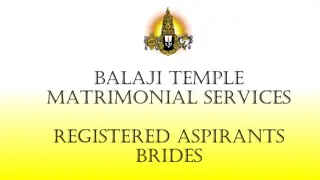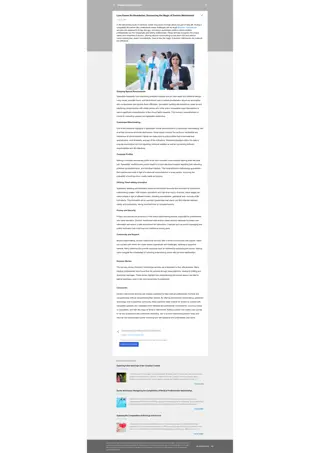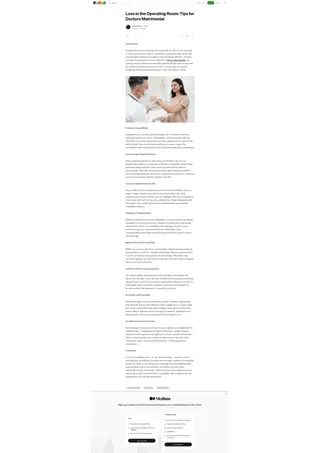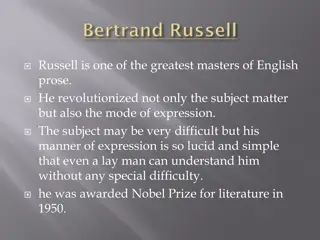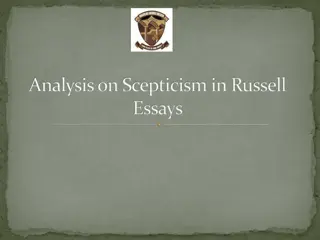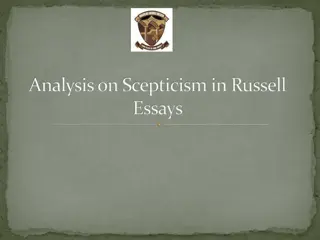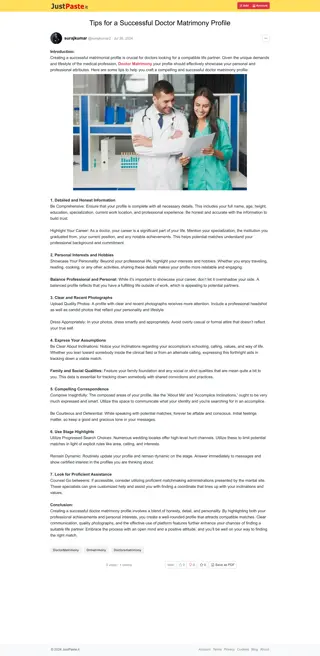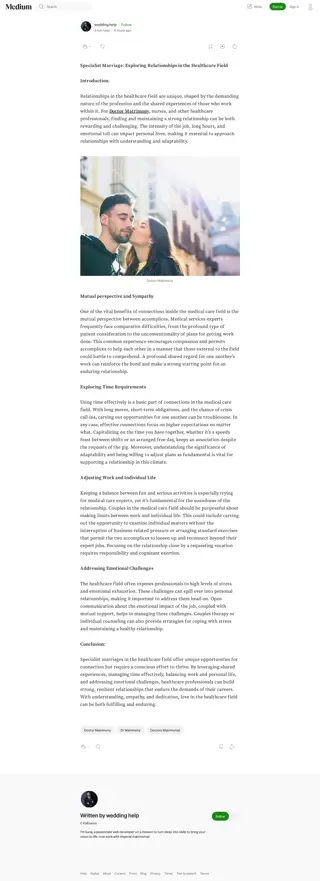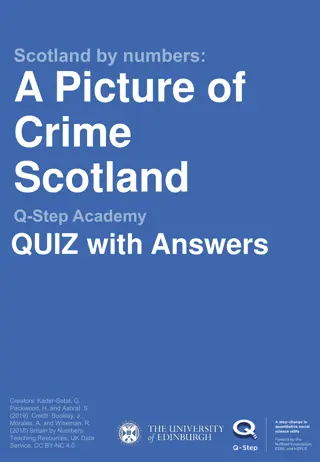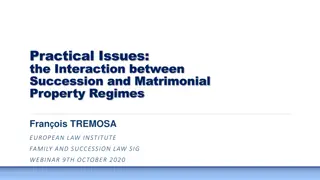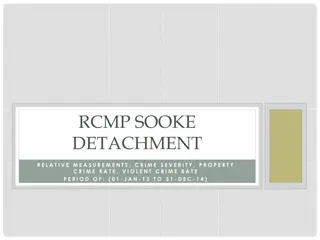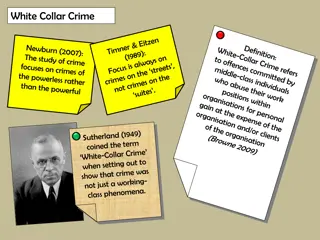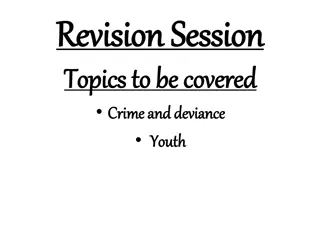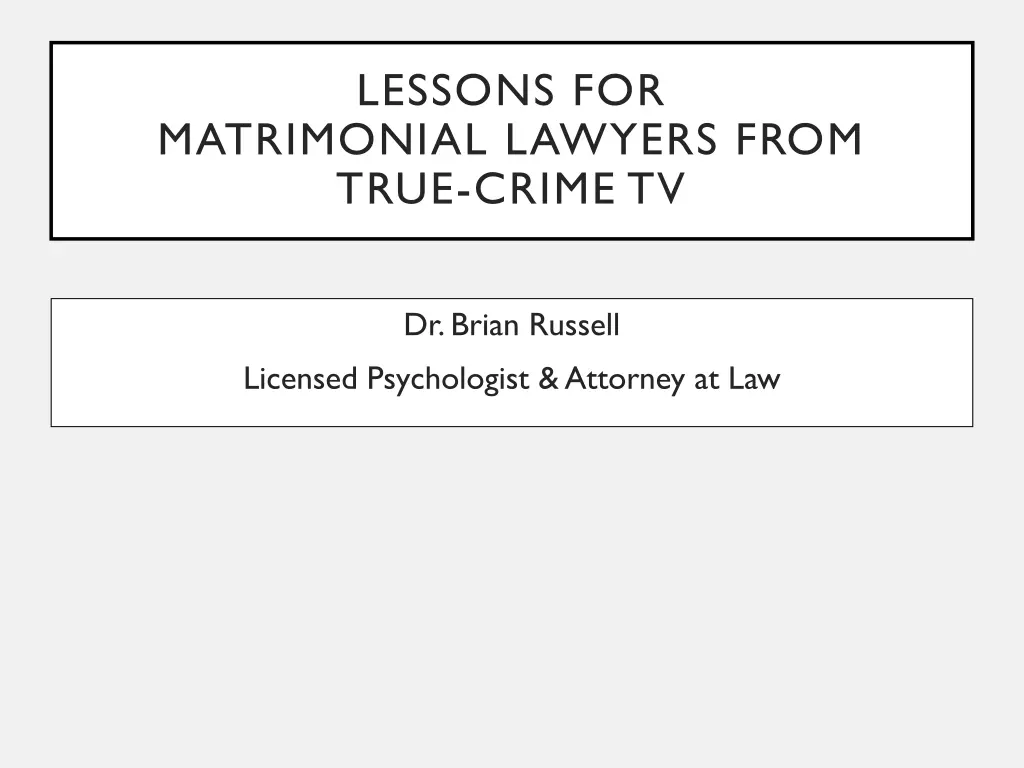
Lessons for Matrimonial Lawyers from True-Crime TV
Discover valuable insights for matrimonial lawyers from true-crime TV cases, highlighting the risks and dangers involved in divorce proceedings, illustrated through real-life stories. From emotional turmoil to potentially elevated risks, these cautionary tales shed light on how divorce can sometimes turn deadly.
Download Presentation

Please find below an Image/Link to download the presentation.
The content on the website is provided AS IS for your information and personal use only. It may not be sold, licensed, or shared on other websites without obtaining consent from the author. If you encounter any issues during the download, it is possible that the publisher has removed the file from their server.
You are allowed to download the files provided on this website for personal or commercial use, subject to the condition that they are used lawfully. All files are the property of their respective owners.
The content on the website is provided AS IS for your information and personal use only. It may not be sold, licensed, or shared on other websites without obtaining consent from the author.
E N D
Presentation Transcript
LESSONS FOR MATRIMONIAL LAWYERS FROM TRUE-CRIME TV Dr. Brian Russell Licensed Psychologist & Attorney at Law
FATAL VOWS 7 seasons Scores of divorces Scores of lawyers involved Scores of litigants committing heinous acts Scores of litigants becoming victims of such acts While not typical, these stories remind matrimonial lawyers that divorce can be murder!
KAHLER CASE (SEASON 1) 1995: Kraig & Karen Kahler marry 1991/1993/1999: Kids Emily/Lauren/Sean are born 2008: Karen begins a relationship with a woman; family moves from TX to MO 2009: Karen hears Kraig has had an affair, files for divorce Kraig is arrested for battery, Karen gets PFA, Karen & kids move out Kraig loses job, moves to KS Karen & kids visit Karen s grandmother in KS Thanksgiving weekend Kraig goes to Karen s grandmother s house. shoots everyone but Sean Karen, Emily, & Lauren die that day, Karen s grandmother 3 days later Kraig is arrested the next day walking down a country road 2011: Kraig gets death sentence (appealed to SCOTUS arguing he was denied an insanity defense under KS law, lost a topic for another talk!)
DIVORCE DANGER ZONES Temporal Leadup (when it s clear marriage s days are numbered) During (when lawyers are actively involved) Aftermath (when it s over, but not really) Emotional Hurt/Anger/Resentment Fear/Desperation Narcissism/Entitlement/Sociopathy
POTENTIALLY-ELEVATED RISKS Disappearing Assets False Accusations Missing Children Violence Toward Multiple Possible Victims Spouse Spouse s Affair Partner Self Kids (& Potentially Other Relatives)
TOMASSONI CASE (SEASON 4) 1983: Gary & Helen Tomassoni marry 1985/1993: Kids Jack & Ryan are born 1989: Gary starts gambling at a local casino 2005: Gary wins $250,000 at the casino, pays off debts, takes Helen on trip Gary continues gambling and loses a lot of what s left of the money Helen demands Gary stop & get treatment & he agrees to 2007: Helen is murdered in the marital home Evidence shows Gary kept gambling, lost everything, mortgaged home 2008: Gary is convicted of murder for insurance money, gets 45 years
DISAPPEARING ASSETS In many cases: Diversion of marital assets predates divorce Gambling Affairs Diversion of marital assets ramps up when divorce is impending Lawyers can help stop the bleeding & recoup some lost assets or get offsets for clients
CASE OF THE FRACTURED FAMILY Early-career custody-evaluation case Child had Osteogenesis Imperfecta Parent A offered ER records to prove Parent B negligent & unfit Statistical analysis of fractures showed: More fractures occurred during Parent B s parenting time Parent B also had more parenting time Controlling for parenting time, slightly more risk with Parent A Parent A did not seem intentionally fraudulent Parent A did seem angry with & disrespectful of Parent B, self- righteous, & desperate to minimize loss of parenting time
FALSE ACCUSATIONS In many cases: Litigants falsely allege domestic violence. Litigants falsely allege child abuse. Sometimes, it s deliberate (i.e., abusive in itself). Other times, it s genuinely believed yet still false. Lawyers, too, can help whether representing accused or accuser (sometimes accusers think an accusation is their only hope or is justified by emotional abuse).
CASE OF THE KIDNAPPED KANSANS 2014: Mid-divorce, Bogdana Mobley flees to her native Russia taking: Her daughter from a previous marriage Her daughter with then-husband Brian Mobley, Sophia, now 6 Her then-unborn second child with Brian, Isabella, now 5 2014-2017: Bogdana lets Brian see the girls by Skype, demands cash for visits 2017: Bogdana returns to KS to file child-support paperwork Arrested by FBI Charged with international parental kidnapping & attempted extortion 2019: Bogdana gets 7 years for parental kidnapping & 2 extortion counts 2020: Fed. appeals court overturns extortion convictions, Bogdana is released having already served the max. for parental kidnapping, kids remain in Russia according to National Center for Missing & Exploited Children
PARENTAL KIDNAPPING D.O.J. National Incidence Studies of Missing, Abducted, Runaway, and Throwaway Children (dated, early 2000s) ~200,000 cases in a yr. (9% of all kids who go missing) Most taken from home (7% from school) Usually were with perpetrator immediately prior Almost always in divorce/split-custody situation boys, girls, 44% < age 6 Fathers more than twice as likely to perpetrate Same racial breakdown as general population
PARENTAL KIDNAPPING, CONTINUED D.O.J. National Incidence Studies of Missing, Abducted, Runaway, and Throwaway Children 35% summer (Jun.-Aug.) 91% returned 79% < 1 mo. 46% < 1 wk. 23% < 1 day 6% not returned but located ~2% not returned/located (deceased?, overseas?)
VALLOW CASE 2003: Charles & Lori Vallow marry 2019: Charles petitions for divorce, alleges Lori threatened his life, gets a PFA Charles petitions for full custody of their adopted son Joshua, 7 Charles alleges Lori said she was a god helping Christ to return in 2020 Charles then dismisses divorce petition Charles is shot & killed by Lori s brother, who claimed self-defense Lori s brother dies (of natural causes but under investigation) Lori marries widower (since charged with murder) Chad Daybell Joshua & Tylee (Lori s daughter from a previous marriage, 17) go missing 2020: Joshua s & Tylee s remains found on Chad Daybell s property 2021: Chad Daybell & Lori Vallow charged with the kids 1st-degree murders
MURDER Violence and Gender 2019 2237 domestic-partner homicides in 2017 1527 female victims Doesn t include homicides of/by affair partners
DIVORCE AS PRECIPITATING FACTOR Chances of someone involved in a divorce getting murdered are higher when there has been: Domestic-violence history Infidelity Multiple potential perpetrators, motives, & victims Financial trouble Window closing on opportunity &/or fear of future Child-custody issues (especially fear of loss of custody)
TRAGIC OUTCOMES Financial devastation Reputations ruined Kids losing parents Death Long-term separation Kidnapping Prison (lasting conflict about what to believe) Kids being killed
TIPS FOR LAWYERS Consider not offering free consultations for divorces (to discourage efforts to conflict you out ). Watch for erratic behavior (on either side). Listen for erratic talk (e.g. , about confronting _____). Counsel clients about realities of court orders (PFAs, custody...) Keep a list of local resources Psychologists (therapists as well as potential experts) Shelters Counsel clients about complications of moving on prematurely. Review relevant professional-conduct rules.
MODEL RULE 1.6 (IN PART) Rule 1.6, Confidentiality of Information, Client-Lawyer Relationship (a) A lawyer shall not reveal information relating to the representation of a client unless the client gives informed consent, the disclosure is impliedly authorized in order to carry out the representation or the disclosure is permitted by paragraph (b). (b) A lawyer may reveal information relating to the representation of a client to the extent the lawyer reasonably believes necessary: (1) to prevent reasonably certain death or substantial bodily harm;
MODEL RULE 1.16 (IN PART) Model Rule 1.16, Declining or Terminating Representation (b) Except as stated in paragraph (c), a lawyer may withdraw from representing a client if: (4) the client insists upon taking action that the lawyer considers repugnant or with which the lawyer has a fundamental disagreement;
MODEL RULE 1.18 (IN PART) Model Rule 1.18, Duties to Prospective Client (a) A person who consults with a lawyer about the possibility of forming a client-lawyer relationship with respect to a matter is a prospective client. (b) Even when no client-lawyer relationship ensues, a lawyer who has learned information from a prospective client shall not use or reveal that information, except as Rule 1.9 would permit with respect to information of a former client. (c) A lawyer subject to paragraph (b) shall not represent a client with interests materially adverse to those of a prospective client in the same or a substantially related matter if the lawyer received information from the prospective client that could be significantly harmful to that person in the matter, except as provided in paragraph (d). If a lawyer is disqualified from representation under this paragraph, no lawyer in a firm with which that lawyer is associated may knowingly undertake or continue representation in such a matter, except as provided in paragraph (d).
MODEL RULE 3.1 (IN PART) Model Rule 3.1, Meritorious Claims and Contentions A lawyer shall not bring or defend a proceeding, or assert or controvert an issue therein, unless there is a basis in law and fact for doing so that is not frivolous, which includes a good faith argument for an extension, modification or reversal of existing law.
MODEL RULE 3.4 (IN PART) Model Rule 3.4, Fairness to Opposing Party and Counsel A lawyer shall not: (b) falsify evidence, counsel or assist a witness to testify falsely, or offer an inducement to a witness that is prohibited by law; (e) in trial, allude to any matter that the lawyer does not reasonably believe is relevant or that will not be supported by admissible evidence, assert personal knowledge of facts in issue except when testifying as a witness, or state a personal opinion as to the justness of a cause, the credibility of a witness, the culpability of a civil litigant or the guilt or innocence of an accused; or (f) request a person other than a client to refrain from voluntarily giving relevant information to another party unless: (1) the person is a relative or an employee or other agent of a client; and (2) the lawyer reasonably believes that the person's interests will not be adversely affected by refraining from giving such information.
MODEL RULE 4.4 (IN PART) Model Rule 4.4, Transactions With Persons Other Than Clients (a) In representing a client, a lawyer shall not use means that have no substantial purpose other than to embarrass, delay, or burden a third person, or use methods of obtaining evidence that violate the legal rights of such a person.



